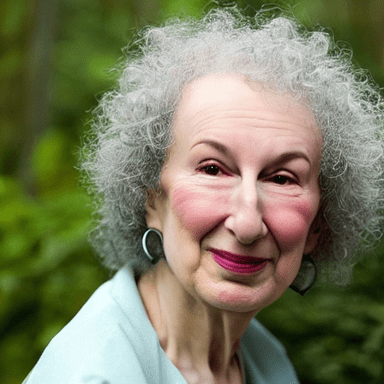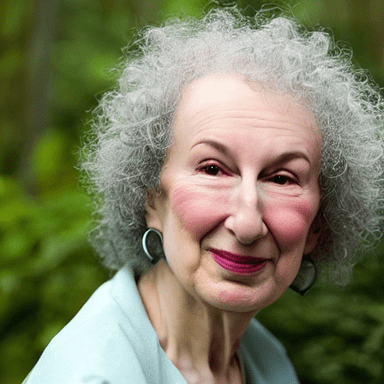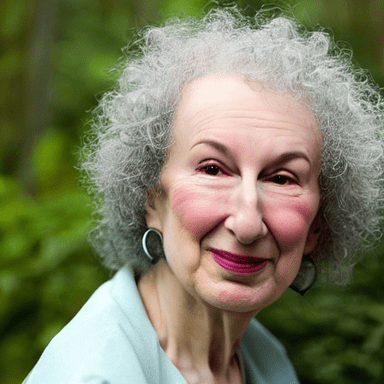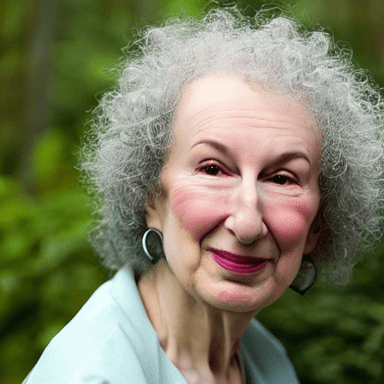
Margaret Atwood Study Guide
Margaret Atwood, a towering figure in the literary realm, has graced the world with her poignant narratives and stark reflections on society. Her magnum opus, 'The Handmaid's Tale', unfurled a dystopian world, resonating profoundly amidst cultural dialogues on feminism and political authority. Beyond this hallmark, Atwood's literary canvas is vast and variegated, spanning novels, poetry, essays, and graphic novels, each bearing the imprints of her incisive intellect and narrative finesse.
Life Facts
- Birth: Margaret Atwood was born on November 18, 1939, in Ottawa, Ontario, Canada.
- Education: She attended Victoria College at the University of Toronto, Radcliffe College, and Harvard University.
- Early Literary Endeavors: Atwood published her first collection of poetry, 'Double Persephone', in 1961.
- Debut Novel: Her first novel, 'The Edible Woman', was published in 1969.
- Iconic Work: 'The Handmaid’s Tale' was published in 1985, later adapted into a highly successful television series.
- Awards: She has received numerous awards including the Booker Prize, Arthur C. Clarke Award, and Governor General’s Award.
- Multi-genre Writer: Atwood has written novels, poetry, essays, and graphic novels, showcasing her literary versatility.
- Apocalyptic Trilogy: She authored an apocalyptic trilogy consisting of 'Oryx and Crake' (2003), 'The Year of the Flood' (2009), and 'MaddAddam' (2013).
- Recent Work: 'The Testaments', a sequel to 'The Handmaid’s Tale', was published in 2019.
- Literary Influence: Atwood has been a significant influence in the realms of feminist and speculative fiction.
- Environmental Advocacy: Besides her literary career, Atwood is also known for her environmental advocacy.
- Honorary Degrees: She has received numerous honorary degrees from universities across the globe.
- Teaching Career: Atwood has had teaching stints at various universities including the University of British Columbia, Sir George Williams University, and the University of Alberta.
- Personal Life: She was married to Jim Polk from 1967 to 1973, and later to Graeme Gibson from 1973 until his death in 2019, with whom she has a daughter named Eleanor.
Interesting Facts
- Unfinished Doctorate: Margaret Atwood started a doctoral degree but did not complete her dissertation.
- Booker Prize Winner: Her novel 'The Blind Assassin' won the prestigious Booker Prize in 2000.
- Canongate Myth Series Participation: She participated in the Canongate Myth Series, where she retold the myth of Penelope in 'The Penelopiad'.
- Early Ambition: Atwood knew she wanted to be a writer by the age of 16.
- Honorary Degrees: She holds dozens of honorary degrees from institutions worldwide, acknowledging her literary contributions.
- Inventor: Besides writing, Atwood invented the LongPen, a device that allows for remote writing, signing documents, and handwriting transmission.
- Environmental Activist: Atwood is a well-known environmental activist and a supporter of green causes, often intertwining environmental themes in her literary works.
- Comic Book Writing: She wrote a graphic novel series called 'Angel Catbird', venturing into the comic book world.
- Birdwatching: Atwood is an avid birdwatcher, a hobby that she has often shared with her late partner, Graeme Gibson.
- Political Engagement: She is known for her political engagement and outspokenness on various issues including human rights, environmental issues, and the importance of literature.
- Numerous Awards: Over her career, Atwood has amassed a multitude of literary awards, accolades, and nominations.
- Extensive Bibliography: With over fifty books of fiction, poetry, and critical essays, her literary output is extensive and diverse.
- Literary Prescience: Often credited with a sort of literary prescience, many readers and critics note how her speculative fiction often mirrors or predicts societal trends.
Early Life and Education
Born into the crisp autumn of 1939 in Ottawa, Ontario, Margaret Atwood’s life was poised for an enthralling literary journey. Her early dalliances with nature amidst the serene woods of Northern Quebec nurtured a deep-seated reverence for the natural world, a theme intricately woven through her later works. Her scholarly voyage commenced at Victoria College, University of Toronto, meandered through Radcliffe College, and found profound engagements at Harvard University, each stage meticulously nurturing her literary saplings.
Amidst the ivory towers, her literary inclinations began to manifest robustly. The world glimpsed the first rays of her poetic expression in her debut collection, 'Double Persephone', which was met with encouraging accolades. This early recognition was not merely an award; it was a clarion call heralding the arrival of a literary luminary. As her verses found a voice, so did her resolve to explore the narrative landscapes further. This formative phase was less about the laurels and more about the unyielding promise of a writer whose words would later echo through time, challenging and changing the societal discourse. Margaret Atwood was not just learning; she was evolving, her every thought weaving the fabric of what would become a resonant literary legacy.
Literary Career: The Formative Years
Margaret Atwood’s literary journey truly commenced with the publication of 'The Edible Woman', which opened a discourse on feminine identity amidst a changing societal landscape. This novel exhibited her adeptness in melding feminist essence with engaging storytelling. The pathway from this debut to her groundbreaking work, 'The Handmaid’s Tale', was embroidered with a myriad of literary endeavors, each reflecting a maturation of her narrative craft and thematic explorations.
In this formative phase, Atwood juggled her passion for writing with a stint in academia, imparting knowledge across various universities. Her domestic life also saw a new chapter with her marriage to writer Jim Polk, although this union was ephemeral. These personal experiences, both within and outside the academia, enriched her literary perspective, providing a nuanced understanding of human relationships and societal dynamics which she deftly encapsulated in her works.
As her literary horizon expanded, so did her engagement with different genres and forms. Her essays, poetry collections, and short stories began to garner attention, setting the stage for the monumental success that 'The Handmaid’s Tale' would eventually achieve. Each piece she penned during this period wasn’t merely a book or a poem; it was a stepping stone that honed her voice, sharpened her narrative prowess, and solidified her standing as a formidable feminist writer. This period laid the robust foundation upon which Atwood’s illustrious career would flourish, marking her ascent from a promising writer to a profound literary icon.
Mainstream Success and Acclaim
The publication of 'The Handmaid’s Tale' marked a seminal moment in Margaret Atwood's career, catapulting her to the forefront of literary acclaim. This dystopian narrative resonated deeply with readers and critics alike, earning prestigious accolades such as the Arthur C. Clarke Award and Governor General’s Award. The tale's haunting portrayal of a totalitarian society encapsulated in Gilead provided a stark reflection of gender dynamics and authoritarianism, enthralling a global readership.
Simultaneously, Atwood’s involvement in academia and literary circles burgeoned. Her eloquence transcended the pages of her books to echo through lecture halls and literary discussions, inspiring and challenging minds. She engaged with budding writers and seasoned academics alike, her voice a profound influence in literary dialogues.
Her presence in academic realms was not merely as a successful author, but as a voracious learner and a thoughtful critic. She navigated through literary forums with a blend of humility and authority, always open to discourse and discussion.
This phase of mainstream recognition didn't eclipse her intrinsic urge for exploration and expression. Instead, it fueled further literary endeavors, reinforcing her standing as a sagacious storyteller and a critical thinker. Each accolade, each discussion, and each critique during this period didn't just symbolize recognition; it epitomized the growing resonance of Atwood's literary voice in the wider socio-political spectrum. This was not merely success; it was the manifestation of a narrative that would continue to challenge conventional norms and stimulate critical discussions, underscoring Margaret Atwood’s indelible mark on the literary realm.
Explorations in Genre and Narrative
Margaret Atwood's literary odyssey is a testament to her adeptness in traversing diverse narrative landscapes. Her storytelling prowess shines across dystopian vistas, historical tapestries, and mythological retellings, offering readers an enthralling journey through varied facets of human experience. Her Booker Prize-winning magnum opus, 'The Blind Assassin', exemplifies her ability to intertwine complex narratives with historical nuances, further solidifying her position in the literary pantheon.
Her exploratory zeal didn't halt at conventional genres. By contributing to the Canongate Myth Series and reimagining Shakespeare's 'The Tempest' in 'Hag-Seed', Atwood bridged the chasm between classical lore and contemporary narrative styles. These ventures showcased her exquisite capacity to don modern sensibilities while treading through classical narratives, thus offering a fresh lens through which readers could appreciate age-old tales.
Atwood's foray into mythological narrative was not just a retelling but a profound exploration of timeless human themes juxtaposed against modern societal dynamics. Similarly, her Shakespearean expedition was not merely a retelling but a modern-day discourse engaging with ageless human dilemmas.
Her narrative explorations extend beyond genre confines, embodying a rich tapestry of characters, eras, and societal reflections. Through each genre, Atwood challenges readers to delve into complex human and societal interactions, encouraging a deeper understanding and discourse.
This period of genre and narrative explorations enriched the literary field with a unique blend of the classical and the contemporary, further showcasing Margaret Atwood's boundless narrative ingenuity and her relentless quest for literary exploration and discourse.
Recent Literary Endeavours and Continued Legacy
Margaret Atwood's relentless literary exploration continues to manifest in her recent works. 'The Testaments', a compelling follow-up to 'The Handmaid’s Tale', is a striking narrative that revisits the dystopian realms of Gilead, offering a new vantage point on the totalitarian theocracy. This work resonated profoundly, illustrating Atwood's unfading ability to engage with contemporary societal discourses through speculative fiction.
Her apocalyptic trilogy, comprising 'Oryx and Crake', 'The Year of the Flood', and 'MaddAddam', epitomizes her adeptness in speculative narratives. Through these works, Atwood delves into the dystopian and the apocalyptic, engaging with themes of environmental demise, genetic engineering, and the human propensity for self-destruction, all wrapped in captivating storytelling.
Today, Atwood’s literary legacy is not stagnant but continues to burgeon. Her narratives, both past and recent, serve as literary beacons, illuminating the path for both budding and seasoned writers. Her distinctive voice, coupled with an unyielding quest for narrative exploration, continues to influence the literary domain. Each novel, each essay, and each poem she crafts adds a new layer to her enduring legacy, reinforcing her standing as a literary icon whose works continue to engage, challenge, and inspire across the global literary landscape.
Influence and Inspirations
Margaret Atwood's literary canvas reflects the nuanced strokes of influences from literary giants like George Orwell, Alice Munro, and Virginia Woolf. Their narrative techniques and thematic explorations echo through Atwood’s works, melding with her unique voice to produce riveting storytelling. Her pioneering role in feminist literary discourse and speculative fiction is a testament to her ability to synthesize these influences into a narrative style distinctly her own.
Her profound engagement with feminist discourse and speculative narratives has not only attracted a global readership but also catalyzed critical dialogues that extend beyond the literary domain into societal arenas. Atwood's oeuvre invites readers and societies to engage in introspection and dialogue on prevailing norms and future trajectories. Through her works, she continues to challenge conventional narrative frameworks and societal norms, igniting reflections and discussions that contribute to the broader societal discourse. Margaret Atwood’s enduring influence is an eloquent demonstration of how literature can transcend the written word and spur thought and dialogue on critical societal issues.
Conclusion
Margaret Atwood's illustrious literary voyage crafts an indelible legacy, with narratives deeply etched in the global literary conscience. Her thought-provoking works continue to evoke introspection and dialogue on the intricacies of human and societal dynamics, affirming her enduring mark on the literary landscape and beyond.
Further Exploration
To delve deeper into the nuanced narrative world of Margaret Atwood, a thorough exploration of her extensive oeuvre is indispensable. Engage with her novels, poetry, essays, and graphic novels to experience firsthand her narrative acumen. Complementing this, diving into critiques and scholarly analyses can provide a richer understanding of the thematic resonances and literary techniques employed in her works. Some suggested readings include critical essays and books on Atwood's feminist and speculative fiction narratives. Engaging with literary forums, discussions, and attending lectures or talks by or on Atwood can also enrich one’s appreciation of her literary contributions. Through a combination of firsthand reading and scholarly exploration, one can traverse the expansive and insightful literary landscape crafted by Margaret Atwood, gaining a deeper understanding of the societal dialogues and human conditions she explores through her words.



